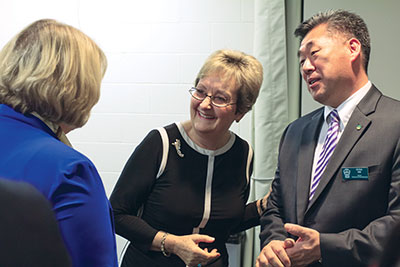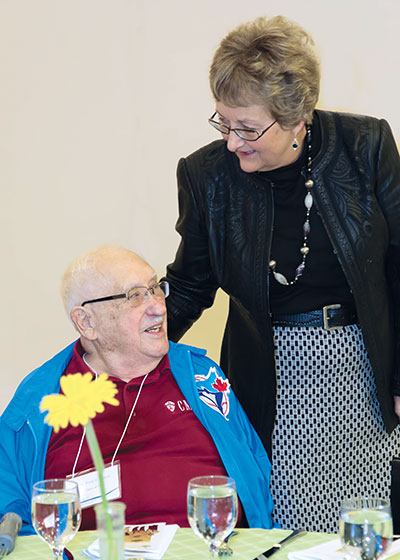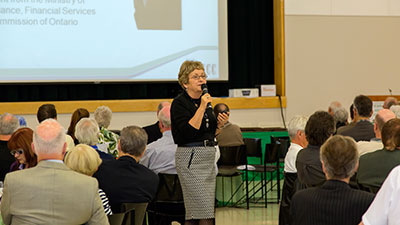
A strong leader is, in spirit, a pioneer – a person who is open to, and excited about, exploring uncharted areas and is willing to take difficult roads, even when an easier course presents itself.
A strong leader is, in spirit, a pioneer – a person who is open to, and excited about, exploring uncharted areas and is willing to take difficult roads, even when an easier course presents itself.
 |
|
| Dr. Moss speaks with Health Minister Deb Matthews and CMCC’s Dr. Peter Kim at the launch of the Centre for the Study of Disability Prevention and Rehabilitation. Photo: Canadian Memorial Chiropractic College Advertisement
|
Within the profession of chiropractic, there is a woman who has personified this pioneer spirit throughout her long and illustrious career. Building on the foundations laid by those who initiated the profession, Dr. Jean Moss, president of the Canadian Memorial Chiropractic College (CMCC), has advocated for innovative, if challenging, directions for chiropractic. Her perseverance and tenacity have paid off, and today, CMCC’s program represents an internationally renowned and respected paradigm for chiropractic education – one that is increasingly being emulated in chiropractic schools and is being noticed by educators in other health-care disciplines.
Such an achievement, many would say, deserves recognition, and Dr. Moss has received a number of accolades for her hard work since she embarked on her career in the 1960s.
First of many firsts
Dr. Moss was originally drawn to chiropractic as a result of two occurrences: first, despite a bleak medical prognosis, her mother, who suffered from a low-back condition, experienced a successful outcome as a chiropractic patient; and second, a family friend and recent graduate of CMCC returned to Bournemouth, England (Dr. Moss’s home town), excited about his new career and the chiropractic education he had received in Canada. He informed young Jean, who was by then already considering pursuing a career in health care, and investigating a chiropractic program – the first outside of North America – that was opening in Bournemouth. Undaunted by the school’s infancy, she signed up as a student in the Anglo-European College of Chiropractic’s (AECC) inaugural class.
“One professor,” she recalls of her first year in this new college, “Dr. Sidney Cooke, taught us much of our first year. He had a unique ability to teach and was the best teacher I have ever had.”
Due to some issues with the dean, however, Dr. Cooke was soon replaced by another teacher, a gentleman who had a PhD in a discipline other than chiropractic. She and her peers could not warm up to his instruction, and began to explore other institutions where they could study chiropractic. CMCC seemed like a reasonable option. However, the AECC students soon ran into some open conflict with schools in North America: it seemed they had been blacklisted on this continent. One of her classmates, Dr. Lynton Giles, met with Dr. Earl Homewood – then the dean of CMCC – and the AECC contingent (10 eager students) were soon accepted at 252 Bloor St. in Toronto.
“Ten fee-paying students, even if they sounded like troublemakers, was too good to miss, so we started at CMCC in second year – on probation,” recalls Dr. Moss.
A student’s student
At CMCC, young Dr. Moss established herself early as a thought leader and a powerful advocate for chiropractic students and excellence in chiropractic education.
“Being considered as a student advocate during my chiropractic studies gave me a good appreciation of student concerns in my later tenure as a member of CMCC faculty,” she notes.
Dr. Drew Potter, current president of the Canadian Chiropractic Research Foundation, classmate and longtime colleague of Dr. Moss, recalls, “Even back then, Jean seemed to be the leader as she was outspoken and never afraid to voice her opinion. During our time at CMCC she was a serious student who knew what she wanted and as I recall she was well-liked and respected.”
Dr. Moss proudly describes the success that the AECC students were collectively able to accomplish: “We could more than hold our own with the rest of the class. None of us had much money so we all worked almost full time as well as attending our classes. Somehow, we all managed to pass all of our exams and graduated in 1970.”
Entry into education
Dr. Moss soon discovered that she had not only an interest in student issues but also an aptitude and passion for being an educator herself.
 |
|
| Dr. Moss with CMCC alumnus Dr. Ross Baker, class of 1951. Photo: Canadian Memorial Chiropractic College |
“After graduating in May 1970,” she says, “I entered practice with Dr. David Drum, a faculty member at CMCC and one of the busiest chiropractors in Toronto at the time. In January 1971, I was asked to become a clinician. It wasn’t long before I was asked to become a tutor in technique classes, which I continued doing for almost 20 years. It was a great experience to take a student through three years of technique and then to watch them succeed in clinic.”
Dr. Douglas Brown, current president of the Canadian Chiropractic Historical Association, recalls, “I got intimately involved with CMCC in 1973, when I became a part-time, second-year technique instructor. In 1974, Dr. Jean Moss joined our group and I witnessed her ambition and ability to teach students a variety of adjusting procedures.”
Dr. Moss soon became more intricately involved in the various elements of chiropractic education: by 1976, Dr. Brown mentions, she had already donned the hat of assistant professor at CMCC and had begun mounting the administrative ladder. She worked tirelessly, eventually becoming the director of both Clinical Sciences and Student Affairs, while successfully achieving her MBA at York University. Dr. Moss became executive vice-president in 1988, and from 1990 to 1991 simultaneously held this position along with the post of acting president. She was appointed president in 1991.
Margaret Butkovic, library director at CMCC and longtime colleague and friend, notes, “I remember Dr. Moss’ inauguration day and how proud we were. At that time, she had a limitless number of plans for the future of CMCC… she has worked tirelessly to build CMCC.”
Dr. Scott Haldeman is an internationally acclaimed chiropractor and the head of the World Spine Care initiative, as well as a neurologist and associate professor of neurology at the University of California at Irvine. Having known Dr. Moss since they were both young DCs, he notes, “Jean’s dedication and ambition to improve the educational experience of chiropractic students never wavered. She was at every meeting and conference, volunteered to serve on any committee where she felt she could make a difference and worked non-stop to attain her goals.”
What were these goals?
When asked what exactly her vision is for chiropractic education, Dr. Moss replies, “My vision is to provide the best possible education to our students so that they can become members of the health-care team. I believe strongly that chiropractors should be equal members of the health-care team. In order for this to occur, chiropractors must be viewed as being able to contribute to the team – the best way for this to happen is for chiropractors to work together with other health-care professionals. CMCC has opened a number of doors in this regard.”
 |
|
| Dr. Moss addressing the Homecoming attendees. Photo: Canadian Memorial Chiropractic College |
Dr. Lesley Biggs from the University of Saskatchewan has worked with Dr. Moss on the Commission on Accreditation of the Canadian Federation of Chiropractic Regulatory and Educational Accrediting Boards and, more recently, as one of two Canadian representatives to the Council on Chiropractic Education (International). She states, “I have always admired Dr. Moss’s vision for the chiropractic profession. In the past 20 years, CMCC has been transformed from a good chiropractic school to a leader in educating people to not only be good chiropractors, but good health-care practitioners as well. In addition, Dr. Moss initiated the education of chiropractor/PhDs, who have become leading researchers in universities across Canada. These accomplishments are astonishing when you think that it wasn’t that long ago when chiropractors were treated, at best, as second-class practitioners in the health-care system.”
Allan Freedman, who serves as legal counsel to and instructor at CMCC, adds, “Jean has helped CMCC and the profession to jump through hurdles and climb mountains that a lesser person might well have avoided. She has also added to the integrity and image of the profession as they relate to the advancement of research, the relationships established with other health-care facilities and the establishment of external clinics at hospitals.”
President emeritus of York University, Dr. Lorna Marsden, and Dr. Jean Moss have worked together on CMCC-related projects in the past. Dr. Marsden notes, “Jean is a great person to work with, sensible in her approach to the wider community and a whiz at engaging citizens in her views.”
A woman’s perspective
All who know her say that Dr. Moss has dedicated her career to developing a chiropractic education system aimed at making chiropractic more accessible to Canadians by installing DCs firmly into mainstream health care through collaboration, research and the development of more integrative policy. Unrealistic as this paradigm may have seemed some decades ago, the industry has seen it come to fruition and Dr. Moss’s tireless efforts have played no little part in this.
Discussions surrounding her formidable contributions to the profession’s development don’t even attempt to avoid mentioning Dr. Moss’s gender. Dr. Moss is the first female president at CMCC, and is, today, the sole female president of any chiropractic program in the world. Discussions concerning her gender often focus on the fact that she is a woman who has been influential in a male-dominated profession, to the point of, on many occasions, completely supplanting her male colleagues and/or their approaches. This has not always provoked the kindest of reactions.
In remembering her days as an instructor, Dr. Moss notes, “I was one of the very few female clinicians and technique tutors and spent quite a bit of time helping the female students become more effective adjusters. However, the attitude of some of the male interns was interesting: the idea of having a woman show them how to adjust a patient didn’t necessarily always go down well. I even remember being introduced once to a patient as ‘Nurse Moss.’ ”
But there are many who laud Dr. Moss, as a woman, for her accomplishments. Dr. Biggs states, “She has become a role model and mentor to me, particularly since there were so few women in leadership positions.”
Friends and colleagues enjoy pointing out her capacity to balance being a chiropractic leader, educator, organizational leader and advocate with other elements. Freedman notes, “In addition to being a hands-on president of CMCC, she is also a wife and mother.”
CMCC’s Butkovic clearly enjoys her moments with Dr. Moss, “comparing notes on how our grandchildren are doing.”
It is not significant that Dr. Moss has done battle in a male-dominated boardroom. It is, instead, important to note the role she has been able to play in initiating a balance within the profession, between approaches espoused by male practitioners and the perspective of a female – who is also a caring daughter, wife, mother and grandmother – in developing and nurturing what is, after all, a healing art.
Mentors, moments and musings
The list of Dr. Moss’ mentors and heroes is an extensive one, but right at the top is her family – her husband Frank Tantalo and children, Nick and Tania. As she says “without their support none of this would have been possible. There have been many, many reorganized weekends and special family events that had to be organized around my schedule. Never once have they complained and yet my travel schedule must have sometimes driven them crazy.”
She is very clear that the success of CMCC “can only be achieved by significant teamwork.” After much consideration, she decided not to name individuals – as there are simply too many – who, over the years, have contributed in many different ways to the story of CMCC. These individuals know who they are, she says. “I am extraordinarily lucky to have had the privilege of serving the profession and being in a position to influence its direction. I can’t thank enough all of those who have supported me and CMCC over the past 23 years.”
This last comment brings Dr. Moss to consider one of the highlights of her career. “My most memorable moment as CMCC president occurred on the opening of our new facility at 6100 Leslie St. I see the building as a statement about CMCC and the profession: it symbolizes what a profession can do when it pulls together.”
“Unfortunately,” she says, “there continues to be division within the profession and difficulty establishing an identity. A great deal of time and resources are spent on these discussions – time that could be better spent on other things. We all need to remember that those who are most hurt by this waste are our patients, our potential patients and the health of Canadians.
“My initial inspiration for taking this path has never faltered. One of the greatest thrills is to successfully treat a patient and make an impact on their life.”
Dr. Moss concludes, “If it were possible to meet those who initiated our profession, I would ask them how they felt about the profession they founded and where it is today. I would ask if this was the future that they had envisioned.”
Dr. Moss has been a global visionary and a leader within the profession of chiropractic. Her pioneer spirit has fuelled her passion to influence and improve the direction that the profession is taking – and every first that she achieved, initiated or supported, has continued to remind her of how much is possible.
In September, CMCC has announced Dr. Moss will be stepping down as president effective June 30, 2014. The author would like to thank Dr. Moss for her support and for her thoughtful and instructive comments, over the years.
Print this page